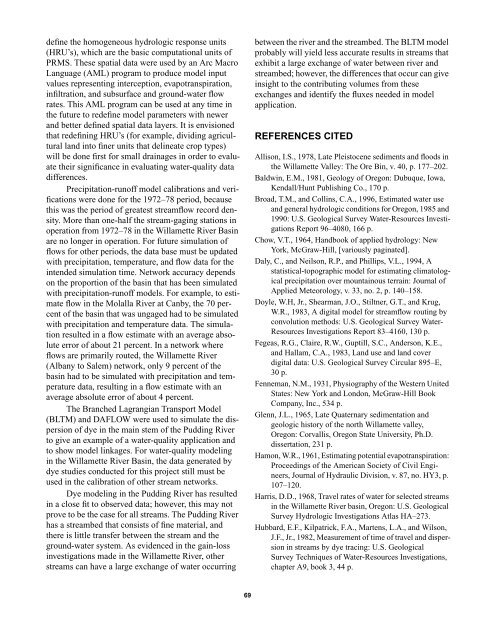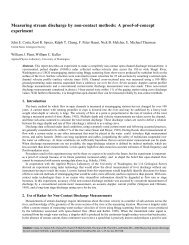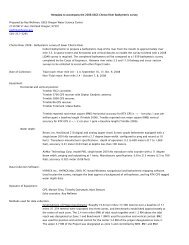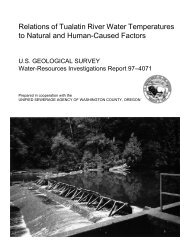Precipitation-Runoff and Streamflow-Routing Models for the ...
Precipitation-Runoff and Streamflow-Routing Models for the ...
Precipitation-Runoff and Streamflow-Routing Models for the ...
- No tags were found...
Create successful ePaper yourself
Turn your PDF publications into a flip-book with our unique Google optimized e-Paper software.
define <strong>the</strong> homogeneous hydrologic response units(HRU’s), which are <strong>the</strong> basic computational units ofPRMS. These spatial data were used by an Arc MacroLanguage (AML) program to produce model inputvalues representing interception, evapotranspiration,infiltration, <strong>and</strong> subsurface <strong>and</strong> ground-water flowrates. This AML program can be used at any time in<strong>the</strong> future to redefine model parameters with newer<strong>and</strong> better defined spatial data layers. It is envisionedthat redefining HRU’s (<strong>for</strong> example, dividing agriculturall<strong>and</strong> into finer units that delineate crop types)will be done first <strong>for</strong> small drainages in order to evaluate<strong>the</strong>ir significance in evaluating water-quality datadifferences.<strong>Precipitation</strong>-runoff model calibrations <strong>and</strong> verificationswere done <strong>for</strong> <strong>the</strong> 1972–78 period, becausethis was <strong>the</strong> period of greatest streamflow record density.More than one-half <strong>the</strong> stream-gaging stations inoperation from 1972–78 in <strong>the</strong> Willamette River Basinare no longer in operation. For future simulation offlows <strong>for</strong> o<strong>the</strong>r periods, <strong>the</strong> data base must be updatedwith precipitation, temperature, <strong>and</strong> flow data <strong>for</strong> <strong>the</strong>intended simulation time. Network accuracy dependson <strong>the</strong> proportion of <strong>the</strong> basin that has been simulatedwith precipitation-runoff models. For example, to estimateflow in <strong>the</strong> Molalla River at Canby, <strong>the</strong> 70 percentof <strong>the</strong> basin that was ungaged had to be simulatedwith precipitation <strong>and</strong> temperature data. The simulationresulted in a flow estimate with an average absoluteerror of about 21 percent. In a network whereflows are primarily routed, <strong>the</strong> Willamette River(Albany to Salem) network, only 9 percent of <strong>the</strong>basin had to be simulated with precipitation <strong>and</strong> temperaturedata, resulting in a flow estimate with anaverage absolute error of about 4 percent.The Branched Lagrangian Transport Model(BLTM) <strong>and</strong> DAFLOW were used to simulate <strong>the</strong> dispersionof dye in <strong>the</strong> main stem of <strong>the</strong> Pudding Riverto give an example of a water-quality application <strong>and</strong>to show model linkages. For water-quality modelingin <strong>the</strong> Willamette River Basin, <strong>the</strong> data generated bydye studies conducted <strong>for</strong> this project still must beused in <strong>the</strong> calibration of o<strong>the</strong>r stream networks.Dye modeling in <strong>the</strong> Pudding River has resultedin a close fit to observed data; however, this may notprove to be <strong>the</strong> case <strong>for</strong> all streams. The Pudding Riverhas a streambed that consists of fine material, <strong>and</strong><strong>the</strong>re is little transfer between <strong>the</strong> stream <strong>and</strong> <strong>the</strong>ground-water system. As evidenced in <strong>the</strong> gain-lossinvestigations made in <strong>the</strong> Willamette River, o<strong>the</strong>rstreams can have a large exchange of water occurringbetween <strong>the</strong> river <strong>and</strong> <strong>the</strong> streambed. The BLTM modelprobably will yield less accurate results in streams thatexhibit a large exchange of water between river <strong>and</strong>streambed; however, <strong>the</strong> differences that occur can giveinsight to <strong>the</strong> contributing volumes from <strong>the</strong>seexchanges <strong>and</strong> identify <strong>the</strong> fluxes needed in modelapplication.REFERENCES CITEDAllison, I.S., 1978, Late Pleistocene sediments <strong>and</strong> floods in<strong>the</strong> Willamette Valley: The Ore Bin, v. 40, p. 177–202.Baldwin, E.M., 1981, Geology of Oregon: Dubuque, Iowa,Kendall/Hunt Publishing Co., 170 p.Broad, T.M., <strong>and</strong> Collins, C.A., 1996, Estimated water use<strong>and</strong> general hydrologic conditions <strong>for</strong> Oregon, 1985 <strong>and</strong>1990: U.S. Geological Survey Water-Resources InvestigationsReport 96–4080, 166 p.Chow, V.T., 1964, H<strong>and</strong>book of applied hydrology: NewYork, McGraw-Hill, [variously paginated].Daly, C., <strong>and</strong> Neilson, R.P., <strong>and</strong> Phillips, V.L., 1994, Astatistical-topographic model <strong>for</strong> estimating climatologicalprecipitation over mountainous terrain: Journal ofApplied Meteorology, v. 33, no. 2, p. 140–158.Doyle, W.H, Jr., Shearman, J.O., Stiltner, G.T., <strong>and</strong> Krug,W.R., 1983, A digital model <strong>for</strong> streamflow routing byconvolution methods: U.S. Geological Survey Water-Resources Investigations Report 83–4160, 130 p.Fegeas, R.G., Claire, R.W., Guptill, S.C., Anderson, K.E.,<strong>and</strong> Hallam, C.A., 1983, L<strong>and</strong> use <strong>and</strong> l<strong>and</strong> coverdigital data: U.S. Geological Survey Circular 895–E,30 p.Fenneman, N.M., 1931, Physiography of <strong>the</strong> Western UnitedStates: New York <strong>and</strong> London, McGraw-Hill BookCompany, Inc., 534 p.Glenn, J.L., 1965, Late Quaternary sedimentation <strong>and</strong>geologic history of <strong>the</strong> north Willamette valley,Oregon: Corvallis, Oregon State University, Ph.D.dissertation, 231 p.Hamon, W.R., 1961, Estimating potential evapotranspiration:Proceedings of <strong>the</strong> American Society of Civil Engineers,Journal of Hydraulic Division, v. 87, no. HY3, p.107–120.Harris, D.D., 1968, Travel rates of water <strong>for</strong> selected streamsin <strong>the</strong> Willamette River basin, Oregon: U.S. GeologicalSurvey Hydrologic Investigations Atlas HA–273.Hubbard, E.F., Kilpatrick, F.A., Martens, L.A., <strong>and</strong> Wilson,J.F., Jr., 1982, Measurement of time of travel <strong>and</strong> dispersionin streams by dye tracing: U.S. GeologicalSurvey Techniques of Water-Resources Investigations,chapter A9, book 3, 44 p.69







